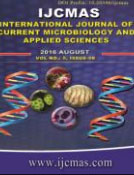


 National Academy of Agricultural Sciences (NAAS)
National Academy of Agricultural Sciences (NAAS)

|
PRINT ISSN : 2319-7692
Online ISSN : 2319-7706 Issues : 12 per year Publisher : Excellent Publishers Email : editorijcmas@gmail.com / submit@ijcmas.com Editor-in-chief: Dr.M.Prakash Index Copernicus ICV 2018: 95.39 NAAS RATING 2020: 5.38 |
Bacterial infections remain an important cause of paediatric mortality and morbidity. It might be possible to reduce these factors by early diagnosis and proper management. The aim of the study was to analyze the bacteriological profiles with their antibiogram, and to register the risk factors for septicemia in neonates and infants. Setting and design: This study was conducted in a tertiary care teaching hospital at S.P.Medical College, Bikaner, India, and included clinically suspected cases of septicemia in neonates and infants. Blood culture reports were studied in 239 cases of clinically suspected septicemia in neonates and infants, using the standard technique of Mackie and McCartney. The antibiotic sensitivity was performed by Kirby-Bauer's disc diffusion method. Risk factors for sepsis in the children were registered. Elevated CRP, TLC, Band cell count, micro ESR laboratory parameters were taken into account. Blood culture was positive in 45.25% of cases. Gram-negative septicemia was encountered in 71.42% of the culture-positive cases. Klebsiella pneumoniae were the predominant pathogens amongst gram-negative organisms in both early & late onset septicaemia. Amongst the Gram positive organism, Enterococci (16.67%) were predominant. Ceftriaxone, third generation cephalosporin, was sensitive only against Enterococcus fecalis while cefoperazone & cefotaxim both have activity against Klebsiella & coagulase negative Staphyloccus. ceftazidime was active against Klebsiella, E.coli & Pseudomonas. CRP levels were elevated in 136 (56.9%). The most important risk factors of septicemia in our study population were preterm birth (13.49%). As the cultures showed variable antibiogram with complicated patterns of resistance, culture and sensitivity test should be performed in all cases of septicaemia.
 |
 |
 |
 |
 |